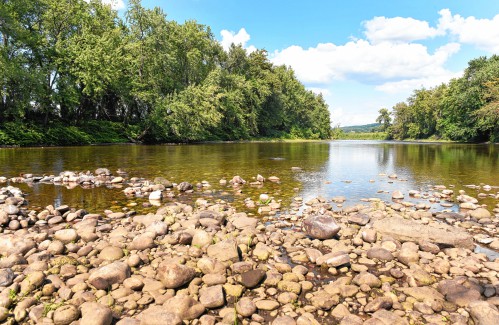Evidence of the Level 3 Critical Drought declaration can be seen across the Connecticut River Valley, from browning grass to canceled car washing fundraisers. But one particular body of water remains largely unscathed.
Much of the Deerfield River continues to have a consistent flow. Due to the dam companies and reservoirs along the river, the water levels are not based on natural flow, thus creating one of the only destinations for water sports in the area.
“The drought is certainly impacting downstream water levels on the Deerfield River, since many natural flow tributaries are significantly lower than average,” said Nathan Marr, directing of marketing at Berkshire East, which offers whitewater rafting. “However, due to the dams and reservoirs along the river, minimum flows have been established — and are released — to sustain flora and fauna.”
John Ragonese, Federal Energy Regulatory Commission license manager for Great River Hydro, which operates seven hydroelectric stations on the Deerfield River, explained when there are dry flow conditions, such as during this severe drought, the flow of conserved water is often higher than the natural flow of the river would be.
Ragonese went on to say there are two large storage reservoirs, one in Vermont and one straddling the border of Vermont and Massachusetts. These reservoirs are used to control river flow, augmenting the adverse effects of the drought.
On the Connecticut River, however, conditions differ.
“The Connecticut River has been abnormally low,” Len Greene, head of external affairs at FirstLight Hydro Generating Co., said in an emailed statement. “Flows are half the long-term mean flow they were last year.”
Greene explained FirstLight’s dam does not contribute to the conditions, but the company is impacted by the drought. With less water in the Connecticut River, less power is generated.
“Our ability to generate with our conventional and run-of-river hydro stations has been hindered, to a degree,” he said, noting that any power not generated by hydro will be offset by other energy generation, including non-renewable energy. “Our generation contributes directly to the grid mix, so any loss of hydropower due to drought requires other generation to fill the gap.”
Ragonese explained the same problem is happening with dams on the Deerfield River. Even though they maintain a minimum flow, there is potential for there to be much more water in the river, generating more power.
The drought is not only affecting the power generated by dams, but also recreation associated with the rivers.
Many fishermen are confined to the Deerfield River for their fishing tours thanks to the more regular flows, and set dates for dam releases that are scheduled in advance.
“From an environmental standpoint, dams aren’t the best thing, but without dams there would be no recreation in the summertime,” said Jonathan Bunker, owner of Square-Tail Anglers Guide Service, which has been offering guided fly fishing tours on the Deerfield, Millers and Swift rivers since 2010.
“When we have rain, you can float other rivers,” Bunker continued. “During the heat of the summer, the Deerfield is the only game in town.”
Brian Lynch, owner of Monroe-based Pheasant Tail Tours, explained most of the tributaries have become warm in the summer heat. If the water is over 70 degrees, it becomes unfishable. He said the Deerfield River is the only river that is cool enough to fish on during this time of year with the current conditions.
With the limited locations for fishing, anglers are running into each other more often. Lynch explained in other seasons there may be 20 miles of the river available for fishing, allowing for anglers to spread out; currently, there is about 5 miles available.
“The quality of the fishing has been hurt. The fish get caught over and over, so they get smarter,” he explained.
Lynch also said other water-related recreation activities are running into each other, including rafting, kayaking and tubing. This causes crowding along the river.
Marr explained drought years are not a bad thing for business at Berkshire East. The scheduled whitewater releases allow for advanced planning for recreation.
“These recreational releases draw paddlesports enthusiasts from throughout the Northeast,” Marr said.
“We are all praying for rain,” Ragonese said. “That’s all we can do.”
Bella Levavi can be reached at blevavi@recorder.com or 413-930-4579.
Credit: Source link































